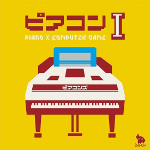Pia-Com I
 |
Album Title: Pia-Com I |
| Record Label: Dog Ear Records |
|
| Catalog No.: DERP-10005 |
|
| Release Date: November 25, 2009 |
|
| Purchase: Buy at CDJapan |
Overview
In 2009, Dog Ear Records producer Hiroki Ogawa teamed up with arranger and pianist Keita Egusa to offer a unique piano collection. Pia-Com I features a collection of classics from the Famicom (or NES for Westerners) arranged in a range of styles, many of them jazz-oriented. Marketed as a mini-album, there are total of seven arrangements featured here, including interpretations of fan favourites from Salamander, Final Fantasy II, and Mother. The release set the foundations for a more expansive sequel album. But how does the original fare?
Body
The opening jazz piano arrangement of Elevator Action is pretty representative of the style Keita Egusa developed for the album. In homage to the simplistic nature of the original piece, Egusa opens the track with a few notes of the original melody against finger snapping, but thereafter offers some richer harmonisation. Egusa goes on to offer a set of variations based on the theme, ranging from an intense bass-driven performance, to a reflective balladic interpretation, to an upbeat lounge-style finish. His arrangement of Mappy has an even stronger ragtime influence and listening to it reminds me of old Charlie Chaplin movies. The theme is quite simple with its short looping melody, but Egusa has a lot of fun with this one and surprisingly manages to extend it to four minutes in length. Both arrangements occasionally drag due to the limitations of the original material, but overall are pretty accomplished.
Egusa appropriately reflects the source material in each of his arrangements. He completely nails the title theme from the early text-based mystery Hokkaido Murders ~The Disappearance of Ohotsuku~, capturing the tragedy of the scenario with the opening harmonics before moving into a very beautiful and mysterious ballad performance. Though it might be too slow for some, I can’t think of an arrangement more fitting for the game. In total contrast is the interpretation of the boss theme from Salamander with its hard brisk rhythms and upbeat chord progressions. Once again, Egusa portrays the excitement and chaos of the game’s boss battles perfectly, even daring to offer some dissonant crashes during the most dramatic portions of the arrangements.
Thhe best track on the album, in my opinion, is dedicated to Konami’s fighting game Yie-Ar Kung Fu. Considering just the music for a moment, this arrangement is an amazing blend of oriental tonalities with avant-garde. But perhaps even more impressive is how well it represents the game. It builds up steadily, first being pretty straightforward and normally paced, before becoming more intense, faster, and angry as the player goes onto the harder fights, sweating, bleeding, crying, before breaking down dead, only to give it another shot and become victorious. This track brings back memories of me screaming that that poor machine. I never in a million years thought I would hear such a well done Yie-Ar Kung Fu arrangement that so fittingly tells the game’s story through music.
Mainstream Western fans will probably find themselves having most affinity to two particularly famous — and sentimental — tracks on this album. Final Fantasy II‘s main theme receives a nod in the second half of the album. Egusa brings out the strength of the original melody, while offering various elaborations and nuances to fill out the arrangement. It’s something of a compensation for the lack of a piano collection for Final Fantasy’s NES trilogy. The last track is probably the fan favourite of the bunch, Mother‘s “Snowman”. Again, this one is very emotionally driven, and has a perfect sense of coldness to it appropriate for the season. At the end, “Eight Melodies” makes an appearance, which gave me goosebumps as it always does. Like me, many will find themselves moved by this arrangement.
Summary
Pia-Com I is a really solid — and sometimes incredible — tribute to the Famicom. It’s particularly impressive how Keita Egusa managed to capture the character and tone of the original games while making the most out of the sometimes limiting melodies. Many will find the short playtime disappointing here, particularly when compared to more expansive collections like Pia-Com II, but the price is appropriately low to compensate. What’s more, every track is a highlight here and no piece ever feels tacked on. If you’re a fan of piano music or the source material, then this album is great value-for-money.
Do you agree with the review and score? Let us know in the comments below!
4
Posted on August 1, 2012 by Audun Sørlie. Last modified on August 1, 2012.














